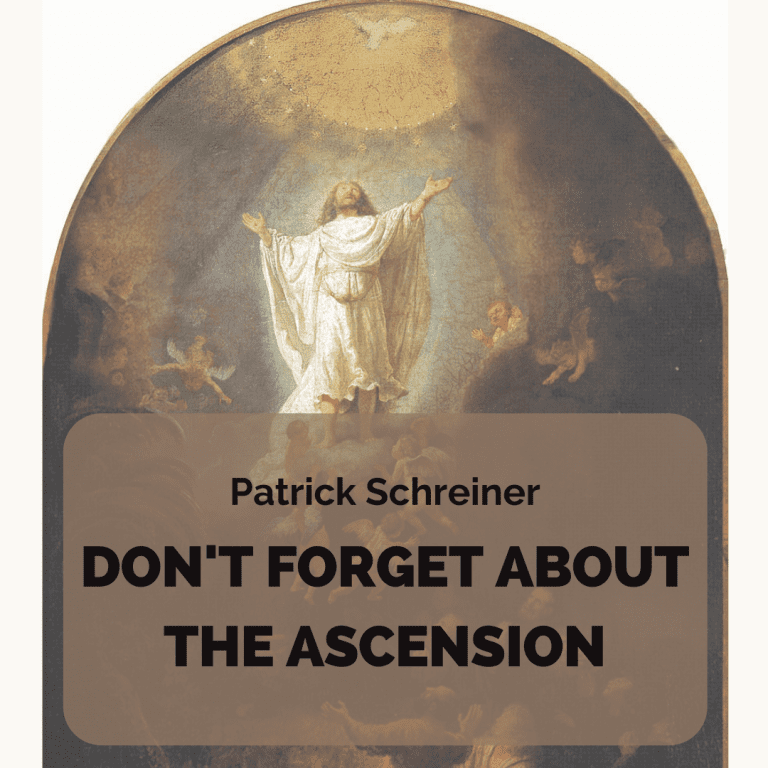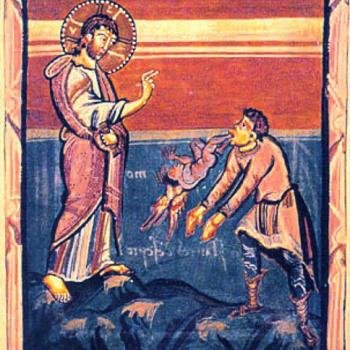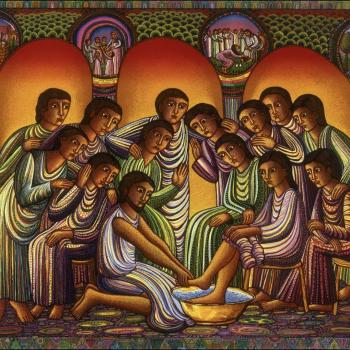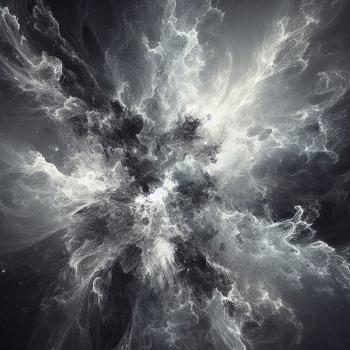I am excited to start a new blog series (don’t worry! The OT/HB series is still ongoing). This one is called, “In Their Own Words…” and features reflections from authors about their new books. The first one is by my friend, Patrick Schreiner. He wrote an excellent study on the doctrine of the ascension of Christ. Here he talks about why this doctrine is important and shouldn’t be neglected in our lived theology.

Pausing the Story
Like many others, I listen to books on Audible. It allows me to engage with different types of literature while I drive or do chores around the house.
One thing I have noticed about audiobooks is that you end up having to stop at odd places. If you are reading a physical book there is usually a more natural ending point. But with Audible, the stopping point can come quite suddenly: a crying kid, a phone call, or a dead battery.
For example, I was listening to the book Ready Player One a few years back and I drove up to the house right when the author said, “And then we all died.”
I tell this story because the same thing can happen when we read the Bible.
Many times, when we tell the story of Jesus we don’t come to the moment of climax or resolution where the story comes complete circle. For example, when you hear about Jesus you will regularly hear about his life, death, and maybe resurrection. But the story usually stops there.
While the doctrine of the resurrection has seen a recent resurgence, the ascension…has not. However, the ascension is a key plot moment, a hinge on which Christ’s work turns. It authorizes and endorses Jesus’s work. It thus functions as a climax of sorts to the Jesus event, but it also continues Christ’s work.
In this post, I will point to the significance of the ascension and then transition to the continuing significance of the ascension from a priestly angle.
The Significance of the Ascension
The ascension refers to Jesus’s rising into heaven. He left the earth and now resides in heaven. It is closely related to what some theologians call his session, which means sitting. Jesus ascended and now sits at the right hand of God.
But why did this need to happen? Could Jesus have stayed on the earth and established the kingdom as the apostles ask in Acts 1? Jesus rebukes them for such thinking. Maybe we need that rebuke too.
Essentially, the ascension affirms Jesus rules forever, over heaven and earth. It confirms Jesus is Messiah and Lord. In the Greco-Roman times, kings would ascend to their earthly thrones and take their seat proving they ruled. But maybe more importantly, according to common stories Romulus (the founder of Rome) and Augustus (the first emperor of Rome) both died and rose up to heaven and became a god who watched over the Romans and the world. These stories would have been known to those watching Jesus ascend.
The confirmation of Jesus’s Lordship also comes from Jewish backgrounds. The prophet Daniel tells of a vision where he saw various nations on the earth represented as beasts, but only the Human One went up with the clouds and the Ancient of Days gave him an everlasting kingdom that ruled over every nation (Dan 7:13-14).
To put this simply, the ascension confirms Jesus’s forever reign. If Jesus does not ascend, he is not established as the Messiah and Lord. If he does not ascend there is a gaping hole in our story. Christians confess Jesus is King because he ascended.
The Continuing Significance of the Ascension
The ascension confirms Jesus’s authority. However, it also continues Jesus’s work. He did not ascend to stop working, but to shift his work into a different gear. He continues to act, as he did upon earth, but in a better way. While we could look at many of his actions, here I want to point to his priestly actions not in Hebrews, but in Luke-Acts.
The Old Testament gave instructions concerning the priestly cult, yet these were only shadows. In these images it became clear the priesthood was lacking––it could never make perfect. The priests served as flawed individuals for a flawed nation. They sacrificed in tents and temples with the blood of animals. They came into service to intercede repeatedly for their own sins and the sins of the nation.
Though the priestly nature of Jesus is not typically a big focus in Luke’s work there are indications that Luke wants us to see his ascension under this banner. It is not until Jesus ascends that he enters completely into his priestly role. Both the end of Luke and the beginning of Acts provide clues in this direction.
The High Priest’s Blessing
First, Luke emphasizes Jesus’s blessing as he is carried up into heaven at the end of his Gospel.
“Then he led them out to the vicinity of Bethany, and lifting up his hands he blessed them. And while he was blessing them, he left them and was carried up into heaven.” (Luke 24:50–51)
Though priests served before God they brought these blessings to God’s people. In the Old Testament, as the High Priest left the Tent of Meeting, they would lift up their hands and bless the people (Lev 9:22-23). This was modeled after both Moses and Melchizedek who blessed Israel and Abraham. Numbers provides the content of the priestly blessing.
The LORD bless you and keep you; the LORD make his face to shine upon you and be gracious to you; the LORD lift up his countenance upon you and give you peace. (Num 6:24-28)
Luke’s point is that Jesus blesses us in a similar way as our High Priest. In Luke God’s blessing is regularly connected with his presence (Luke 1:42, 68-69; 2:28-32). Acts recount this blessing includes the Holy Spirit and John 14:26-27 connects the gift of the Spirit with the High Priest’s blessing in Numbers. Jesus affirms in the Helper will teach the disciples all things. More specifically Jesus identifies this teaching as, “Peace I leave with you; my peace I give to you” (John 14:27).
Jesus, as the great High Priest, is the new Aaron who extends his hands over the people and gives them peace through the Holy Spirit. His priestly blessing gifts the Spirit––the one who allows peace. Jesus not only gives the Aaronic blessing but fulfills it.
The High Priest’s Ascent
Second, Luke redoubles on the priestly themes in the recount of Jesus’s ascension in Acts 1:9-11 with the reference to the clouds, angels, and Jesus’s rising.
After he had said this, he was taken up as they were watching, and a cloud took him out of their sight. While he was going, they were gazing into heaven, and suddenly two men in white clothes stood by them. They said, “Men of Galilee, why do you stand looking up into heaven? This same Jesus, who has been taken from you into heaven, will come in the same way that you have seen him going into heaven.” (Acts 1:9–11)
If you think back to the Old Testament, a priest would “go up” into the temple or tabernacle. This action was based on Moses’s ascent of Mount Sinai where fire and smoke filled the mountain (Exod 13:21; 19:9; 24:15; 34:5; 40:38). Now those of Aaron’s descent go into the presence of God. And when they go into God’s presence there is smoke (Lev 16:2; Num 12:5; Isa 19:1; Ezek 1:4; 10:4). Not only that but the two men, likely angels, represent that Jesus has gone into the Holy of Holies.
At the ascent, Jesus’s priestly activity on behalf of humanity does not cease but enters into a new era. The Messiah’s ascension allows him to intercede on behalf of humanity in a unique way. Though it is tempting to view Jesus’s sitting at the right hand of God as the completion of his work this is only partially true (Heb 1:3). Jesus does not ascend into the heavens to merely sit and rest. He does not soar into the sky because his intercessory work has concluded. Even in his sitting he continues to serve.
Hebrews 8:1-2 affirms this reality.
Now the main point of what we are saying is this: We do have such a high priest, who sat down at the right hand of the throne of Majesty in heaven, and who serves in the sanctuary, the true tabernacle set up by the Lord not by a mere human being.
We enjoy a high priest who serves in the sanctuary. His vocation is not finished.
Conclusion
Though we might have the tendency to tell the Jesus story without referring to the ascension, the ascension is key plot moment in the gospel story. Jesus is installed as Lord and Messiah. His work is confirmed. But his work is not complete. He still acts.
We have seen here he still acts as our priest. He reaches out his hands and continues to bless us. The gift he gives us is the presence of God through the Spirit. He also continues to serve and intercede for us in heaven. Jesus’s work is not finished. The ascension shows us his work in heaven continues.
We must not only look back on what Christ has done, or what he will do on his return, but turn our eyes to what he is doing now.
Learn more about the book, The Ascension of Christ: Recovering a Neglected Doctrine (Lexham Press)













